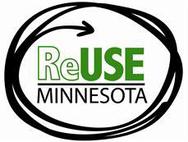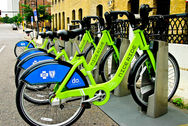|
Have you heard of “collaborative consumption" or the "sharing economy"? They’ve become buzzwords with the rise of companies such as Airbnb and Zipcar. Both terms refer to the same economic model based on people and companies sharing, trading, reusing, and renting goods and services, rather than owning something outright. It can be as easy as sharing a snow-blower with neighbors instead of everyone on the block owning their own, or can be an entirely new business model like Airbnb where people rent out their extra bedroom to tourists. It is reinventing not just what we consume but how we consume.
The sharing economy offers benefits to participants as it strengthens community connections, allows access to goods without the cost of ownership, and reduces the environmental impact of most goods and services. It reminds me of that old adage we all heard in primary school: “Sharing is caring.” In the sharing economy, sharing is caring for your family, your community, and the environment.
There are tons of opportunities to get involved in sharing throughout Minnesota. It's completely up to you how you want to get involved, from the individual to community level, and from sharing cars, to sharing used items, to sharing your skills with neighbors.
So check out some of these ideas on how to join the sharing economy:
 Share your belongings and borrow from others. We all have those belongings that we rarely use and just sit in a closet or garage gathering dust. Why not find a use for them and share them with people in your community! Pass along your favorite books to people in your neighborhood by building a Little Free Library or holding a book-share event. If you have tools or items that you’d like to lend out to people, or are looking for something specific to borrow yourself, then the Sharing Shed might be for you. You can list what you have available to share, and search for items that you could use. Tool libraries offer a similar opportunity where people can checkout tools they need for free from a central location, rather than buying something new. If you want to learn more about how to start a sharing program like a tool library in your own community, then check out these handy instructions provided by the Center for the New American Dream.
|
 Aim for reuse rather than buying new. If borrowing or renting won’t do, then look for something reused, refurbished, or repurposed! ReUSE Minnesota is a great resource for locating businesses and organizations that have used items for sale. You can also use the Hennepin County Choose to Reuse directory to search for specific items that are available used in stores throughout the area. Another great place to look for used products is the Twin Cities Free Market where you can find everything from TVs to dressers to exercise equipment, and the best part is that it’s free! And if you are a business, don’t forget the Minnesota Materials Exchange, a free service that links organizations with reusable goods they no longer need to those who can use them.
|
 Save money by sharing cars and bikes. Owning a car can be expensive, especially given the harsh Minnesota winter conditions, and think about how much time that car just sits around each day. That is why various car-sharing programs such as HOURCAR and Zipcar offer the chance to enjoy the perks of using a car without the steep costs of owning one. When you use Car2Go you don’t even have to return the car to the same parking spot! But cars aren’t the only transportation option that can be shared. You can check out a bicycle at an hourly rate through Nice Ride MN, and when you’re done just return it to one of the kiosks throughout the Twin Cities. This is a great option for commuters or people who only bike occasionally. And finally, perhaps the most commonly used shared-transportation is the bus. Every time you ride the bus you reduce your greenhouse gas emissions, don’t have to worry about finding parking, and save money on car-related expenses! Check out the Metro Transit to find bus routes and learn more about other sharing-based transportation options such as carpooling. It’s never been easier to use a variety of options to get to your destination in a cheaper, more environmentally friendly way.
|
Share your skills. We all have talents and skills that other people might find useful. Why not put them to good use by teaching other people what you can do through a skill-share program. The Experimental College of the Twin Cities is a great chance to take classes taught by people on a range of topics from bike maintenance to film appreciation, or come up with a topic area and teach a class yourself! The classes are free and are a great chance to learn something new from a fellow community member. Similarly, the Hour Dollars program allows community members to swap time and services in an effort to strengthen communities. By completing services for other community members, you earn hours that can then be spent to have someone else help you out with a project. It’s a great way to get to know your community better and also get some work done!
Don’t forget about donating. Ever feel overwhelmed by the amount of stuff you have scattered throughout your house, garage, or basement? No matter what you do, sometimes it seems like stuff just keeps accumulating. A great way to simplify your belongings, while helping others, is to donate your unwanted items to nearby thrift stores like Goodwill or the Salvation Army. You’ll be helping support the work of charity organizations and cleaning out your home. If you have more stuff than you can transport to a thrift store, then a garage sale might work well to reduce clutter. It’s a great way to remove unwanted things from your home, make some money, and ensure that the items are reused rather than traveling to a landfill.
Be creative! Think of new ways to share with your community. You could set up a free-swap with neighbors where people can exchange items, or host a community sharing event. Or perhaps you could organize a community clothing collection of well-maintained clothing to donate to a local second-hand store. Whatever you do, you’ll get something out of it whether it is a less-cluttered closet, meeting your neighbors, or the satisfaction of donating to a great cause.
The Minnesota State Fair is just around the corner. If you're interested in learning more about how you can live greener, then come over to the Eco Experience building. This year the Eco Experience will feature fixologists who will teach you how to make easy repairs to household items to keep them going strong, August 21-September 1, 9 a.m.-9 p.m., Minnesota State Fair Grounds (St. Paul).
Check out the Twin Cities area food co-ops' 4th annual Eat Local Farm Tour. You visit one or more of the farms on the tour to learn all about their process and products from dairy farms to vegetable farms to everything in between, July 19.
The 9th annual Minnesota Garlic Festival includes hundreds of varieties of garlic for you to pick up, live cooking demonstrations, and lots of performances for the whole family. It’ll be a great time, and it’s easy to find—just follow your nose! August 9, 10 a.m.-6 p.m., McLeod County Fairgrounds (Hutchinson).
Thank you for reading Living
Green 365. This newsletter is a publication of the Minnesota Pollution Control
Agency. Please send questions or comments about living green to the address
below.
Sincerely,
Mark Riegel and the Living Green Team
livinggreen365.pca@state.mn.us
|